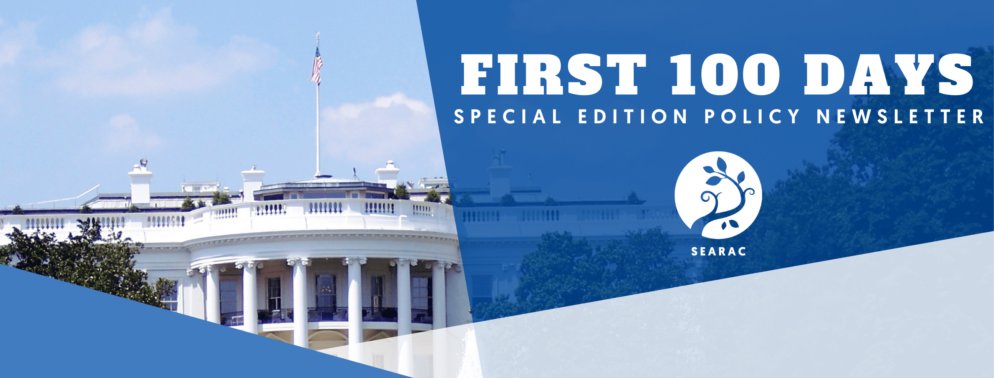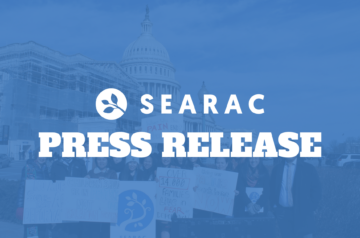Welcome to the final edition of SEARAC’s special edition newsletter providing policy highlights from the first 100 days of the Trump Administration.
Check out our previous policy newsletters:
Mar. 21 edition
Feb. 18 edition
Feb. 3 edition
If you have questions or want to learn more about any of the policies that SEARAC is tracking, contact us at searac@searac.org.
EXECUTIVE ORDERS AND AGENCY ACTIONS
During its first 100 days, the Trump Administration issued a flood of directives and actions undermining equal opportunity and civil rights, dismantling government accountability, and reshaping who gets to live in the United States.
Many of the executive orders (EOs), agency policies, and enforcement actions are being challenged in court or have already been struck down as illegal. The Administration is attempting to silence communities and institutions through fear; intensify our communities’ experiences of hardship, confusion, and violence; and irreparably damage our public institutions.
These directives:
Undermine equal opportunity and civil rights
The Trump Administration is tearing down civil rights protections and opportunities for underserved, underrepresented, and vulnerable communities.
- What does this mean: The Administration is attempting to get rid of lawful policies and practices that promote diversity, equity, inclusion, and accessibility. The directives have been so broad and vague that businesses, schools, and public institutions are overly complying out of fear. Ultimately, the Trump Administration is trying to deny equal opportunity for all people. Remember, EOs cannot prohibit diversity, equity, inclusion, and accessibility practices, which are important for making sure that every person feels valued and respected at work or school. EOs also do not change the fact that certain accommodations, like for people with disabilities or for language access, are still required by law.
- Who will this primarily impact: The attacks on diversity, equity, inclusion, and accessibility are affecting many people, including communities of color like Southeast Asian Americans (SEAAs), people with disabilities, children, and more. The Trump Administration is:
- Ending federal policies, programs, and offices that improve diversity, equity, inclusion, and accessibility, including for women and veterans;
- Cutting federal requirements to improve language access and disability accommodations;
- Terminating federal programs or taking away funding for community organizations that served vulnerable communities and communities of color;
Threatening private companies and colleges and universities into ending their diversity, equity, and inclusion efforts for workers and students; - Preventing students of color from accessing educational opportunities by trying to censor what students learn in school, taking away funding for teachers, encouraging punitive school policies that will disproportionately punish students of color including SEAAs, and undermining the accreditation process that ensures quality higher education programs.
Permit discrimination in workplaces, schools, and government
The Trump Administration is trying to change the meaning of gender to erase trans, intersex, nonbinary, and queer people. These actions not only put LGBTQI+ communities at risk, but also make it harder to collect and access reliable information to support many vulnerable communities, like communities of color, including SEAAs.
- What does this mean: The Administration is trying to force a male/female binary and are erasing information on sexual orientation and gender identity in order to exclude transgender, intersex, nonbinary, and queer people from federal laws, protections, and policies. To implement this, the Administration has removed or changed widely-used datasets and resources that document economic, social, and health inequities.
- Who will this primarily impact: The Administration’s ongoing and widespread meddling in government websites – which has broadly affected sexual orientation and gender identity data as well as disaggregated race and ethnicity data — make it easier to conceal disparities, perpetuate inequities, and further discriminate against marginalized communities. Deleting certain groups of people from government policies and resources does not make them disappear – it just makes it easier to keep discriminating against and marginalizing those communities.
Dismantle public institutions
The Trump Administration is dismantling public institutions and offices essential for civil rights, education access, public safety, and the health and wellness of communities across the country.
- What does this mean: Only Congress can get rid of federal agencies and offices that it created by law. But the Trump Administration is effectively shutting down entire federal programs and offices that provide essential services to communities across the country. It is doing this through unlawful mass firings and by pressuring federal government workers to resign.
- Who will this primarily impact: Many SEAAs, their families, and their communities rely on government programs to survive:Nearly one in five SEAAs live below the federal poverty level for Medicaid eligibility. SEAAs experience higher rates of certain health outcomes, such as mental health challenges like post-traumatic stress disorder, due to their experiences of war, genocide, and displacement. A fully functional Department of Health and Human Services, with experts who focus on communities of color, are essential to promoting SEAA families’ health.
- One in four Vietnamese American children participate in the national free lunch program (disaggregated data are not available for any other SEAA ethnic group). While the free lunch program comes from the Department of Agriculture, this number shows that there are many low-income SEAA students who benefit from their schools receiving federal education funds, including funding for low-income students that come from the Department of Education.
- One in three Hmong Americans, one in five Cambodian Americans, and one in six Lao and Vietnamese Americans receive Supplemental Security Income, which is for older adults and people with disabilities. The Trump Administration’s gutting of the Social Security Administration and other federal agencies put SEAA elders at further risk.
The Trump Administration also eliminated government advisory committees, community engagement offices, and oversight bodies.
- What does this mean: These offices and committees hold the federal government accountable for serving the American people. The affected offices include:White House Initiative on Asian Americans, Native Hawaiians, and Pacific Islanders (WHIAANHPI) — WHIAANHPI was an important government unit that worked across federal agencies and with the White House to support AANHPI communities.
- Census 2030 Advisory Committee (2030 CAC) and Census National Advisory Committee on Racial, Ethnic, and Other Populations (NAC) — These advisory committees were terminated, but they were providing the Census Bureau with recommendations for improving outreach to communities that are historically underrepresented in the decennial census, such as SEAAs. SEARAC’s Executive Director, Quyên Đinh, was an appointed member of the 2030 CAC.
- Even though the Department of Homeland Security is set to receive an enormous increase in funds from Congress to detain and deport people, it has shut down three oversight offices that protect the civil rights of people who interact with immigration enforcement officials.
Reshape who gets to live in the United States
As the Trump Administration dismantles civil protections, they are attacking immigrants and refugees, upending resettlement and reunification of families, and creating a system for mass detentions and deportations.
- What does this mean: The Trump Administration abuses national security concerns to punish immigrants and deport more and more people without due process or regard to people’s rights, regardless of their immigration status or whether they have deportation orders. This includes individuals and families seeking asylum, long-time US residents, and even the US citizen children of immigrants. The Trump Administration is:
- Increasingly using non-federal resources to arrest, detain, and deport immigrants, which are federal responsibilities. This includes tasking local law enforcement and the military to conduct immigration raids, and even using immigrants’ legitimate and intensified fears to push them to take actions on their own.
- Expected to prevent travel to the United States from countries that do not currently accept deportations in order to pressure them into doing so, including Cambodia and Laos.
- Deporting individuals to a country they are not from, such as South Sudan, El Salvador, Panama, Libya, and others, and in cases making them stateless;
- Abducting and deporting non-citizens for their political activism, including lawful permanent residents, particularly students, academics, and community organizers;
- For more information on the Trump Administration’s immigration enforcement and policy changes, read our Feb. 3 newsletter or this policy explainer.
- Who will this primarily impact: Around 15,000 SEAAs live in the United States with deportation orders, despite having completed their sentences. Increasing numbers of SEAAs are being detained and deported, separated from their families and their communities without a second chance. The impacted community members so far have included people facing removal to Cambodia, Laos, and Vietnam; Vietnamese refugees who arrived in the United States before 1995 who are being newly detained or detained; Hmong Americans who were detained or have already been removed to Laos; Cambodian Americans individuals whom ICE is detaining without the 14-day notices currently required by an injunction in a class action lawsuit; elders, including individuals taken from care facilities; and likely many others on whom SEARAC does not have information.
IMPACT ON CALIFORNIA
In response to many of the actions above, California has sued the Trump Administration 16 times in its first 100 days.
- What does mean: These lawsuits include those challenging its cancellation of over $11 billion in grants to local and state health agencies, threats to withhold education funding over diversity programs, termination of K-12 teacher preparation grants, and attempt to revoke birthright citizenship.
- Who will this primarily impact: Lawsuits may take time to resolve, so their impacts are unclear at this time. Attorney General Rob Bonta is expected to continue filing or joining new lawsuits. Earlier this year, state legislators set aside $50 million for these lawsuits.
California faces a budget deficit, which may become more challenging once more details of expected federal funding cuts to safety net programs such as Medi-Cal emerge. The Trump Administration has also threatened to specifically target states like California that provide health coverage for undocumented communities with cuts.
- What does this mean: Gov. Gavin Newsom unveiled his revised budget proposal on May 14. The budget will be negotiated with lawmakers by the end of June, with final adjustments occurring after that. However, the process may take longer, as Congress may not enact its spending plan until the fall. California may need to take on additional costs for programs like Medi-Cal itself should congressional Republican leaders get their way with cuts.
- Who will this primarily impact: With nearly 15 million low-income or disabled residents enrolled in Medi-Cal, California has more to lose on health care than any other state. Four in 10 SEAAs in California utilize public health insurance; our communities could face enrollment freezes, increased drug copays or premiums, restricted benefits, and other types of cuts depending on how negotiations unfold. Gov. Newsom’s revised budget would also freeze enrollment for undocumented adults in Medi-Cal starting in January 2026, and add a $100/month premium for undocumented Medi-Cal enrollees ages 19 and up starting January 2027.
While the Trump Administration has emboldened ICE and a group of extremist sheriffs in California to target immigrant communities, advocates have defeated a set of state bills that would have weakened existing California sanctuary laws, rolled back protections that local governments have enacted, and undermined due process. Despite such policies withstanding these legislative attacks, there are reports of a growing number of SEAAs in Southern California being detained and, in some cases, deported at routine immigration check-ins in recent months.
- Who will this primarily impact: The SEAA immigrants being targeted are typically individuals who were convicted of crimes after arriving in the United States, often due to inadequate resettlement support and struggles with assimilation. Despite serving their time, they are still eligible for deportation once released from jail or prison. However, in many instances, ICE did not carry out the deportations because their orders have been on indefinite hold for years. Under long-standing policies, these individuals were permitted to stay in the country as long as they regularly checked in with ICE and demonstrated that they were employed and abiding by the law. Advocates are also campaigning for state pardons for SEAAs facing deportation that could allow them to remain home with their families and communities.




